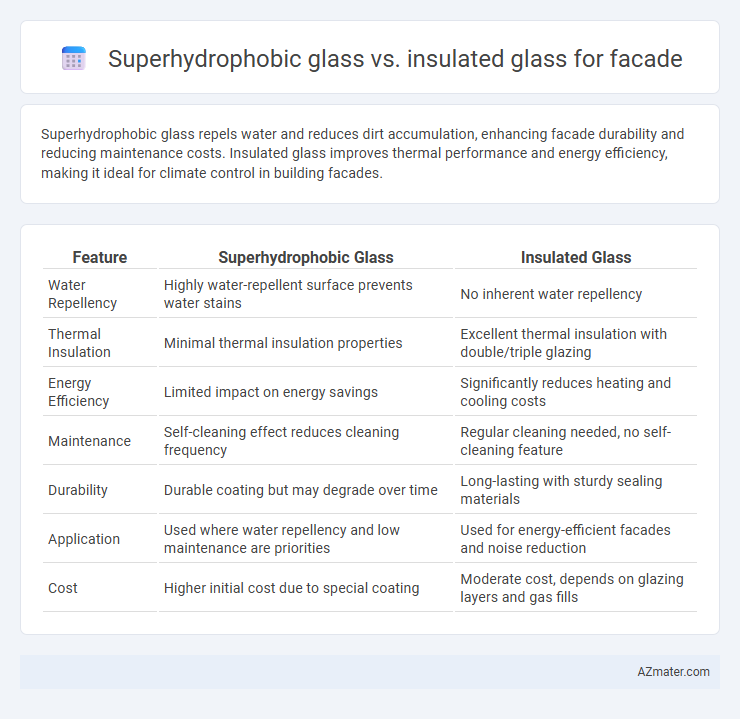Superhydrophobic glass repels water and reduces dirt accumulation, enhancing facade durability and reducing maintenance costs. Insulated glass improves thermal performance and energy efficiency, making it ideal for climate control in building facades.
Table of Comparison
| Feature | Superhydrophobic Glass | Insulated Glass |
|---|---|---|
| Water Repellency | Highly water-repellent surface prevents water stains | No inherent water repellency |
| Thermal Insulation | Minimal thermal insulation properties | Excellent thermal insulation with double/triple glazing |
| Energy Efficiency | Limited impact on energy savings | Significantly reduces heating and cooling costs |
| Maintenance | Self-cleaning effect reduces cleaning frequency | Regular cleaning needed, no self-cleaning feature |
| Durability | Durable coating but may degrade over time | Long-lasting with sturdy sealing materials |
| Application | Used where water repellency and low maintenance are priorities | Used for energy-efficient facades and noise reduction |
| Cost | Higher initial cost due to special coating | Moderate cost, depends on glazing layers and gas fills |
Introduction to Facade Glass Technologies
Superhydrophobic glass features a nanoscale coating that repels water and reduces dirt accumulation, enhancing facade cleanliness and reducing maintenance costs. Insulated glass units (IGUs) consist of multiple glass panes separated by a gas-filled space, providing superior thermal insulation and energy efficiency for building facades. Both technologies improve facade performance but serve distinct functions: hydrophobic surfaces optimize durability and aesthetics, while insulated glass enhances thermal comfort and energy savings.
What is Superhydrophobic Glass?
Superhydrophobic glass features a nano-engineered surface coating that repels water, preventing droplets from adhering and reducing dirt accumulation on facades. Unlike insulated glass, which emphasizes thermal insulation with multiple glass layers and gas fills to enhance energy efficiency, superhydrophobic glass prioritizes self-cleaning and water resistance properties. This innovative material improves facade maintenance by minimizing water spotting and grime build-up, extending the appearance and performance of building exteriors.
Key Features of Insulated Glass
Insulated glass for facades features multiple glass panes separated by a spacer filled with inert gas, enhancing thermal insulation and reducing heat transfer. Its key attributes include improved energy efficiency, soundproofing capabilities, and condensation resistance compared to single pane options. This makes insulated glass ideal for buildings aiming to lower energy costs while maintaining clear visibility and durability.
Performance Comparison: Water Repellency
Superhydrophobic glass exhibits superior water repellency due to its nanoscale surface coating that causes water droplets to bead and roll off, minimizing water retention and staining. Insulated glass lacks this specialized coating and relies primarily on thermal insulation properties, resulting in higher susceptibility to water accumulation and streaking on facades. This makes superhydrophobic glass more effective for maintaining facade clarity and reducing maintenance in wet environments.
Energy Efficiency Considerations
Superhydrophobic glass enhances energy efficiency by reducing water and dirt accumulation, maintaining high solar control and thermal insulation properties without frequent cleaning. Insulated glass units (IGUs) provide superior thermal resistance through multiple glazing layers and gas fills, significantly minimizing heat transfer and improving HVAC performance. Combining superhydrophobic coatings with insulated glass technology optimizes facade energy performance by ensuring lasting transparency and robust thermal insulation.
Durability and Maintenance Requirements
Superhydrophobic glass offers exceptional water and dirt repellency, reducing surface contamination and minimizing cleaning frequency, which enhances long-term durability by preventing moisture-related damage and stains. Insulated glass, composed of multiple panes with gas-filled spaces, provides excellent thermal resistance but requires careful maintenance to prevent seal failure that can lead to fogging and reduced insulation performance. While superhydrophobic coatings increase resistance to environmental wear and simplify upkeep, insulated glass demands regular inspections and potential seal repairs to maintain its durability and energy efficiency in facade applications.
Aesthetic and Design Flexibility
Superhydrophobic glass offers enhanced aesthetic appeal through its self-cleaning properties, maintaining a clear, spotless facade with minimal maintenance and preserving architectural intent over time. Insulated glass provides design flexibility by enabling varied thicknesses and configurations to meet thermal performance standards without compromising visual transparency or structural integration. Both materials support sleek, modern facades, but superhydrophobic glass excels in reducing water marks and dirt accumulation, while insulated glass excels in energy efficiency and acoustic insulation.
Cost Implications for Building Facades
Superhydrophobic glass, featuring a nano-coating that repels water and reduces dirt accumulation, typically incurs higher upfront costs due to advanced manufacturing processes compared to insulated glass. Insulated glass, designed with multiple panes and gas fills to enhance thermal performance, offers cost savings in energy efficiency and reduced HVAC expenses over the building lifespan. Evaluating facade investments, superhydrophobic glass demands a premium price but may lower maintenance costs, whereas insulated glass balances initial expenditure with long-term energy cost reductions.
Environmental Impact and Sustainability
Superhydrophobic glass reduces water and dirt accumulation, decreasing the need for chemical cleaners and frequent maintenance, thereby minimizing environmental pollution and resource consumption. Insulated glass enhances energy efficiency by improving thermal insulation, lowering heating and cooling demands, which significantly reduces greenhouse gas emissions over a building's lifecycle. Choosing between these facade materials depends on balancing water repellent properties with energy conservation goals to optimize sustainability outcomes.
Choosing the Right Glass for Your Facade
Superhydrophobic glass offers exceptional water repellency and self-cleaning properties, reducing maintenance costs and improving facade durability in rainy or humid climates. Insulated glass enhances thermal performance by minimizing heat transfer, resulting in better energy efficiency and indoor temperature regulation in both hot and cold environments. Selecting the right glass for your facade depends on climatic conditions, energy goals, and maintenance preferences to optimize building performance and longevity.

Infographic: Superhydrophobic glass vs Insulated glass for Facade
 azmater.com
azmater.com